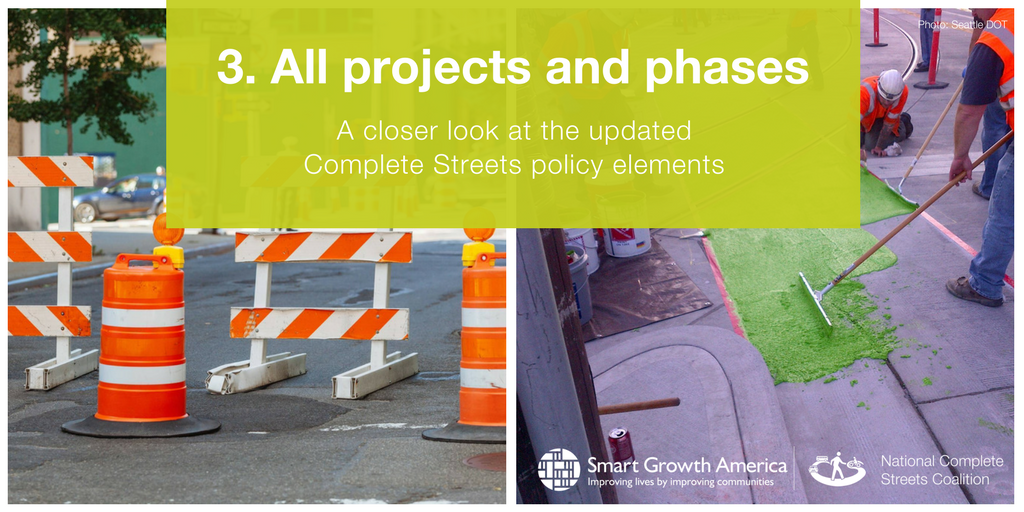
News
By Nimotalai Azeez, November 8, 2017

The ideal Complete Streets policy has a strong commitment that each transportation project and maintenance operation accounts for the needs of all modes of transportation and users of the road network. Existing projects and maintenance should be viewed as opportunities to implement Complete Streets strategies. While this does not mean every street needs to add a bike lane, communities should weigh all of the potential benefits and possible scenarios. We spoke to one of our Steering Committee members Ignacio Bunster-Ossa from AECOM to hear more about how jurisdictions can implement this revised policy element.
This post is part of Complete Streets month at Smart Growth America; we will be sharing a series of blog posts that cover and explain each of the 10 revised policy elements in some detail.
National Complete Streets Coalition: Why should “all projects and phases” be prioritized in Complete Streets policies?
Ignacio Bunster-Ossa: The current changes to transportation are significant and happening fast. For instance, automated vehicles and more personalized transportation options on our devices are expanding the way people choose to get around. Cities and departments of transportation can increase their efficiency by adding a Complete Streets approach to existing maintenance schedules; instead of waiting for capital funds that are not distributed as often to become available to municipalities. The Bicycle Coalition of Greater Philadelphia, for example, works with the streets department during regular repaving maintenance to add traffic calming measures like road diets and other tactical projects.
NCSC: How does “commitment in all projects and phases” apply to different levels of government?
IB: In cities that I’ve worked in, the commitment to complete Streets has been city-wide, and they were charged to improve and facilitate mobility to service the most people. Complete Streets policies have to find out where the need is from a social equity point of view, and if the need is regional or local in nature. Coordination between various levels of government is helpful, especially when the state DOT is responsible for major arterials that run through town.
“Commitment in all projects and phases” is just one of 10 policy elements that will be featured this month. We’ve officially revised our policy grading rubric, known as the 10 Elements of a Complete Streets Policy. The Complete Streets movement has evolved since it began in 2004 to focus far more on implementation and equity, but the framework for grading the quality of policies hasn’t kept pace. For months, a group of national stakeholders, consisting of engineers, planners, researchers, and advocates, worked to revise the policy elements and truly raise the bar for what Complete Streets look like in practice. The entire revised framework will be available on our website on November 30, 2017.
Stay tuned for more Complete Streets updates during the month of November
- Have questions about the changes? Join us as we discuss how the new grading rubric will affect future policies during our webinar on December 1, 2017 at 1:00pm ET. The entire new grading rubric resource will be released on our website shortly before the webinar. Register for the webinar today >>
- We are now accepting nominations for the Best Complete Streets initiatives. Do you know of a project, initiative, event, person, task force, etc. that exemplifies Complete Streets? Fill out this brief nomination form >>
If you have any questions about the changes to the Complete Streets policy framework, please contact us! We’re happy to discuss further.
Special thanks to our featured Steering Committee member:
 “As populations grow, so do demands for safe, expedient and cost-effective transportation. We work with clients around the world to build, modernize and expand transportation projects that carry all of our communities into the future — safely and reliably.”
“As populations grow, so do demands for safe, expedient and cost-effective transportation. We work with clients around the world to build, modernize and expand transportation projects that carry all of our communities into the future — safely and reliably.”
Related News

© 2025 Smart Growth America. All rights reserved
Site By3Lane Marketing
















